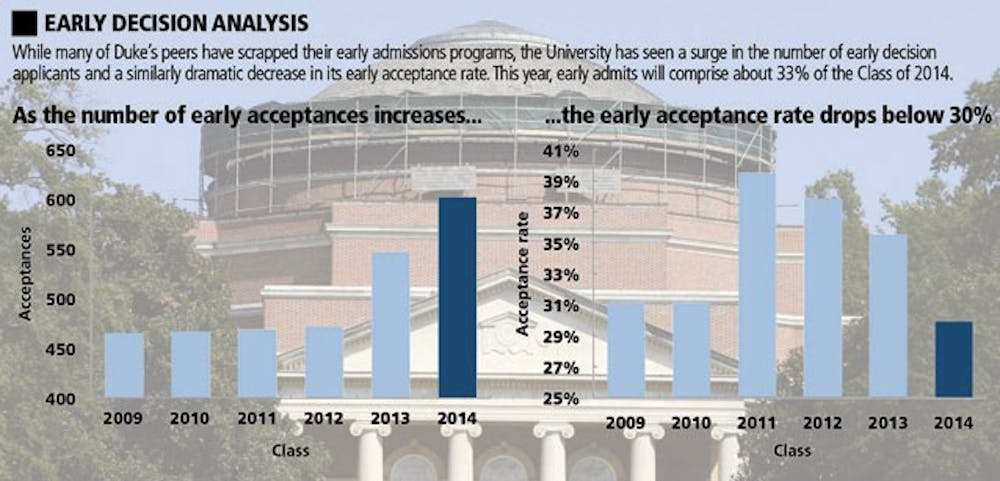Approximately one third of the Class of 2014 will be composed of early decision applicants when Duke’s newest freshmen move in to East Campus next Fall. In the past, early applicants have typically made up about one fourth of the freshman class.
Administrators said this was because last year’s early decision application season left them wishing they had been able to admit more students.
This year, those hopes were fulfilled with the admittance of 50 more students through early decision than usual. Dean of Undergraduate Admissions Christoph Guttentag said this was due to a significant increase in early decision applications this year. Duke admitted 602 early decision applicants in December 2009, and there are currently 1,100 spots remaining in the Class of 2014, Guttentag said.
“Five hundred more applications essentially allowed us to admit 50 more students,” he said.
As the number of applicants increase, the proportion of qualified students increases, Guttentag said. He noted that last year, the University was not able to admit a number of qualified students because of limitations on class sizes, and he did not want that to be a limiting factor this year.
Provost Peter Lange said the fact that early decision applicants have indicated that Duke is their top-choice institution.
“We decided that if we have that many kids committed to Duke, it appeared to be the right decision,” he said.
Guttentag noted, however, that admissions officers had two aims in mind—to admit more students if possible, while also increasing selectivity. Because of the increase in early decision applications, it was necessary to be more selective this year so enough spots remain open for regular decision applicants. Selectivity increased by 4 percent this year, Guttentag said.
Officials believe the increase in early decision admittances will not significantly affect financial aid awarded. Early decision applicants traditionally apply for financial aid at a lower rate than regular decision applicants. In 2006, Jim Belvin, then-director of financial aid, told The Chronicle that about 20 percent of early decision applicants initially qualified for financial aid compared to 45 percent of regular decision applicants who qualified.
Director of Financial Aid Alison Rabil confirmed this, and she wrote in an e-mail that there are fewer early decision students asking and qualifying for aid than regular decision applicants.
Rabil said she does not believe the increase in early decision admittances will reduce her financial aid budget.
“I don’t think our percentage of people who are on aid is going to drop significantly,” she said.
She explained this was because more early decision applicants are applying for financial aid than in the past. In addition, Rabil said she thinks the economic downturn has resulted in more financial aid applicants in the regular decision pool.
“I think in the whole admissions process, we’re going to have more students who are on aid in the regular decision pool than we’ve had before,” she said.
Rabil added that the increase in regular decision admitted students needing aid will offset the increase in early decision acceptances.
“I don’t think we’re in jeopardy of losing any of our economic diversity because of [having] 50 more admits in the early decision pool,” Rabil said. “I think we have plenty of people who can step up to the plate for economic need.”
Get The Chronicle straight to your inbox
Signup for our weekly newsletter. Cancel at any time.

